Day 3: June 12, 1997
STU 師大

Ban Po Museum 半坡博物館 (9 a.m.)
Hua Qing Hotsprings 華清池 (11 a.m.)
The Museum of Terracotta Warriors and Horses of Qin
Shihuang 秦始皇兵馬俑博物館 (1:30 p.m.)
Jade workshop 玉器工場 (4 p.m.)
Dinner of dumplings 餃子宴 (5:30 p.m.)
Tang Dynasty show 仿唐歌舞 (7:30 p.m.)
STU 師大
After the breakfast, we went to Ban Po Museum, which was just in the city of Xi'an, so the journey was short.
Mr. Yue of the STU Students Union travelled with us on that day.
9 a.m.Ban Po Museum 半坡博物館
The four exhibition halls of Ban Po Museum were not big, many pieces of pottery jars and framing tools used by
early human beings were exhibited. Mr. Yue talked with us very often, and joked with us a lot.
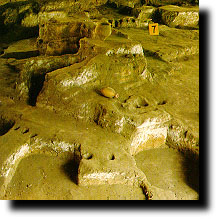 |
|
The Ban Po remains 半坡遺址 |
Then, we went into a hall which was the place where Ban Po people 半坡人 lived
about 6,000 years ago. Inside the hall, we saw the remains of Ban Po people. It was a large open space surrounded
by walkways. The remains was a large piece of land with many holes and trenches in it. The holes served for
different purposes, some were used for cooking, some for food storage, some for storing water
and some were lavatories. There was a deep and wide
trench which separated the area into two halves, because it was a boundary between two families of the ancient people.
The kind of tent which those people lived in was remade in the hall, too. Also, some well-preserved bones of ancient people
were exhibited in wooden containers with a piece of glass on top.
After visiting the remains, we walked around and had a look of the stores there. They were selling souvenirs like traditional
handicrafts and chinawares. I didn't bought any of them since they were quite expensive.
We hurried away and travelled for about an hour to go to the next spot.
11 a.m. Hua Qing Hotsprings 華清池
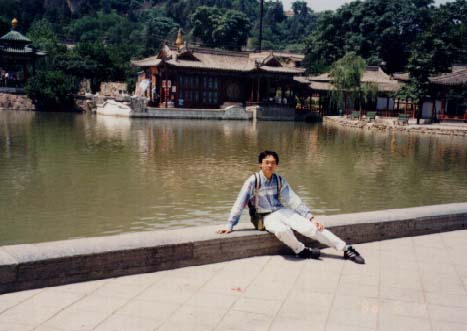 |
| Hua Qing Hotsprings 華清池
|
There were several buildings which were exhibition halls 館. In one of the halls,
there were the bathrooms of Tang Dynasty emporor (唐玄宗) and his beloved Yang Yu-huan
(楊玉環,楊貴妃). Of course, the baths were very big. They were made of well-cut, smooth stones,
and there were even water channels for water supply and discharge. Beside, there were the office
and bedroom of Cheung Kai-Shek 蔣介石, he stayed there before he was captured in "Xi'an event
西安事變". We could see the bed, his table and telephone through the open windows. There was a
stall selling badges. After that, we went into a shop selling souvenirs, including nicely coloured
towels with poems and drawings. There were also jade products, wooden bookmarks with historical
figures drawn on them. I bought some. While others were still buying souvenirs, I went to buy an
ice cream to eat, since I liked ice cream but had not tried the ice cream there. I worried about the hygiene, but,
as I didn't feel sick after these two days, I thought it was all right, and I was right.
We had our lunch in a restaurant beside Hua Qing Hotsprings. We had a dish of chicken! We missed chicken
very much. One dish of vegetables was very good, too, but other dishes didn't suit us. We were talking
about the dishes and were excited. Another surprise was that we were provided rice! In Xi'an, noodles and
congee were the main food, so we hadn't any rice to eat before this meal in Xi'an, and we felt something
was missing after each meal because we had rice everyday in Hong Kong.
Then, we went to The Museum of Terracotta Warriors and Horses 兵馬俑博物館, the journey was just about 10 minutes.
1:30 p.m. The Museum of Terracotta Warriors and Horses of Qin
Shihuang 秦始皇兵馬俑博物館
We entered the gate (like the gates in MTR stations) with magnetic cards like MTR tickets. Firstly, we went into a rounded
theatre. When we entered it, we found that there were TV screens on all the walls, which were 360 degrees around us.
a video was shown introducing the history of Qin 秦 Dynasty and the discovery of terracotta warriors and horses (they were first discovered
by local farmers in 1970s). As we had TV screens around us, when we looked forward, we saw what should be in front of us in the video, and when
we looked back, we saw what should be behind us. Just like we were really in the situation shown in the video. We met many foreigners there.
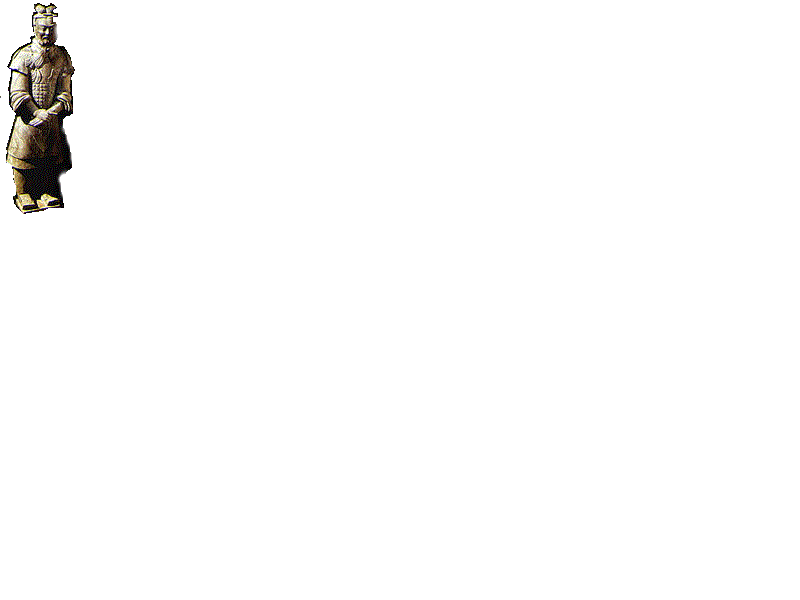 |  |
| Terracotta warriors 兵俑 |
Then, we entered pit no. 1 of the museum. According to the description, it covered an area of 14,260 square meters, containing 6,000 terracotta warriors and
horses and 40 war chariots 戰車. In half of the pit, the warriors were unearthed so that we could see them in rows. Each of them had different faces and height.
We could see the soil beside the terracotta warriors was black, that was because of burning: At the end of Qin Dynasty, Hang Yue 項羽 led his soldiers to burn
the terracotta warriors and took away their weapons. The warriors were not burnt (since they were made of pottery), but the wooden pillars supporting the ceiling
were burnt. The pillars fell down and made clear marks on the soil. Because of this fire, many terracotta warriors were broken. As their weapons were taken away,
we could only find a few pieces of weapons in the pit, and so, many of the warriors' hands were in a position of holding weapons or shooting, but their hands were empty, with no weapons.
Another half of the pit was only soil ground, since the warrior were not yet unearthed. We could not take photos, since the flash light can harm the figures.
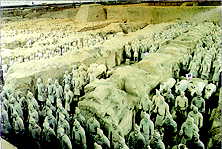 |
| Inside pit 1 of the museum 一號廳內 |
We visited pit 2 afterwards. Its area was 6,000 sq. meters, having 89 war chariots, 356 chariot horses, 116 saddled horses and over 900 warriors, it was a special battle formation.
It was very very big, and some workers were still working inside the pit to unearth the figures. Mr. Yue answered many questions raised by us. Originally, there were colours on the warriors,
but it quickly disappeared after being unearthed, maybe the colour used before didn't tolerate the climate now - 2,000 years after they were buried. So, all of them looked gray in colour now.
As many of warriors are still underground, the state is studying the method of preserving their colours.
Pit no. 3 was much smaller, only 520 sq.m., containing 68 warriors, a colourfully painted chariot and 30 pieces of bronze weapons. It seems to be the headquater of the whole army, since we saw
warriors guarding a room. There was no commander found, because the commander was Qin Shihuang 秦始皇 himself. After that, we saw the bronze chariot
銅車馬, which was also discovered with the warriors, and was well-made.
 | 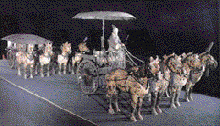 |
| Outside look of a pit 廳外 |
Bronze chariot 銅車馬 |
We went out of the museum and looked for something to buy. Actually someone were selling mini terracotta warriors and horses in the museum area, I bought a set for about Renminbi $10, and some of us bought them too.
but then I discovered that we were foolish. Because when we were out of the museum, we found stalls selling the same thing for $5 and even $2! In economics, the demand is less elastic inside the museum, since
information cost is high (we cannot go outside to check the price in other stalls, and certainly people won't buy souvenir before entering the museum), so that sellers can ask for a higher price. The demand was
more elastic outside the museum since people can obtain price information easily, so sellers compete with each other by cutting price. Anyway, I bought 3 sets of that stuff in different prices: $10, $5 and $2. Some of us bought
small knifes and models of bronze chriot. A funny event happened to Kelvin, he bought a set of terracotta warriors outside the museum, after walking for a few steps he lost his balance while walking down some steps,
the set of warriors fell to the ground, and some of the warriors' heads detached from the bodies. We all laughed at him, and this event became our talking point during the whole trip. In fact, his warriors losing
heads were just like the real warriors inside the museum.
We stayed for quite a while to shop, then, we were on our coach and we drove past the tomb of Qin Shihuang 始皇陵. It was only a small hill (it was very high, but it became shorter after 2000 years of erosion and weathering).
It was not being explored yet, so we didn't visit it.
 Tomb of Qin Shihuang 始皇陵
Tomb of Qin Shihuang 始皇陵
4 p.m.Jade workshop 玉器工場
At about 4 p.m. we were back to Xi'an city, earlier then what it was scheduled, so Mr. Tung brought us to an additional destination, a jade workshop. It was inside a building. We saw how technicians made a piece of jade into
jewellery, and we saw many jade products. Somoe of us, including me, felt it wasn't interesting, so we moved outside to have a walk in the street. To me it was more interesting because I wanted to feel the city life of Xi'an rather
than just going to tourist spots and see the highly artificial decorations.
 |
| A market in the street |
I walked with Kitty, Fat Boy and Carmen. We were walking along a street which was a market. People sold vegetables there, and the meat was put on a table and
was surrounded by flies (Ai-ya...), but we also saw small cakes sold in covered containers, and we bought some. I saw bricks of grass jelly 涼粉 which was WHITE in colour! and I saw tomatoes which were very very big. Also, I went into a toy store
and discovered figures of Dragonball 龍珠, I hoped to find something to buy but I was disappointed, the toys were too new fashioned.
5:30 p.m. Dinner of dumplings 餃子宴
We went to a restaurant not far away to have our dinner of dumplings. We occupied two tables, and there was one stove fueled by solid alcohol on each table, used for keeping the dumplings hot. Altogether we had 18 different dishes of dumplings,
and each of us could have one dumpling from each dish. When the waitress put a dish (in fact, a bamboo container 籠) on our tables, she gave us a story of that kind of dumplings. Some of the dumplings
were big and some were tiny. An interesting kind of dumpling was the one which the dish was full of white substances which looked like snowy ground, and the dumplings were brown and looked like penguins. Some of us didn't like dumplings
because they were sensitive to the vegetable inside. The two of them order a dish of Yangzhou fried rice 楊州炒飯. The price looked reasonable, but when it appeared on our table, its size was too big that even two people couldn't
finish it. After the dumplings, we had water-melon and others, we were all very full.
When we walked out of the restaurant, the sky was still bright. It was strange since we always had our dinner at night in Hong Kong.
7:30 p.m. Tang Dynasty show 仿唐歌舞
 |
| One session of dance in the show |
Then, we went to a theatre called Red Tower Opera Theatre 紅樓大劇院 and watched the Tang Dynasty show. We occupied two tables which were nearest to the stage. There were dances of Tang Dynasty and dances of other tribes like 龜茲舞. Solo music performance of Pi Pa 琵琶 and Gu Zheng 古箏, drum show of Chang An 長安鼓樂, and a dance in which the dancers wore masks of mythical animal (金剛力士). I took some phots, but Mr. Cheung took
many and videotaped it. We only had some drinks, and didn't eat anything.
10 p.m.STU 師大
We returned to STU, had a shower. Then Joe and I walked to TU Road again. We was back to the cassette tape store we visited (not yet closed at 10:30 p.m.)
, and I bought a tape of Cheung Wai-Mui 張惠妹. The shopkeeper played it before I gave him money
(RMB$9.8). I asked him which of the Hong Kong singers had the best sales, he said it was Leon Lai (not Jacky Cheung!). Memorial tapes of Wong Ka-Kui 黃家駒 were very popular too, so Beyond was also selling good there. The assistant
of the shopkeeper said the death of Wong was such a pity (even when he pasted away quite long ago). We talked a little bit. The shopkeeper said he recognized that we had visited the shop before and he thought we were coming from Guangzhou (yet very close).
There were many food stalls beside the street, and the noodles was just several dollars (about RMB$3.5) for a large bowl. We visited a "self-select shop 自選店" (small supermarket, customers choose the items, put it in a plastic basket,
and go to the cashier). We watched football show on TV when we were back to our room before we went to sleep.
Additional photos:
Continue to !
Back to title page of interflow trip
Back to the main index page
Leave me a message if you have any additional information or correction to the above events.
(c)1998 Miu Wan Publishing 渺雲出版社















 Tomb of Qin Shihuang 始皇陵
Tomb of Qin Shihuang 始皇陵
